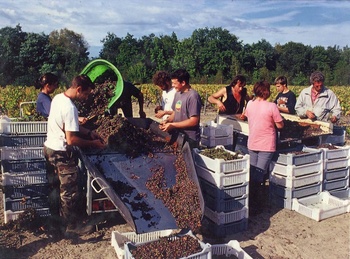
 |
| Located in Montlouis, in the heart of the Loire Valley, Jacky Blot of Domaine de la Taille aux Loups is one of the star winemakers of the region. Originally a Loire wine broker by profession, Blot acquired in 1989 about 8 hectares of 50 to 75 year old vines. These prized, ancient parcels belonged to families that could no longer continue to cultivate the vines, and so entrusted them to Blot and his team. Blot brought a passion and exacting determination to make wines of only the highest quality, well beyond the norm of the day. Now more than 25 years on, Blot is the acknowledged pioneer of the region and is credited with having taken Chenin Blanc to unprecedented heights of quality. The estate comprises 25 hectares in Montlouis and, across the Loire river, Vouvray. It is complemented by 14 hectares in Bourgueil at Domaine de la Butte, which Blot acquired in 2002. The core of the domaine lies in the Montlouis sur Loire appellation, on a plateau overlooking the Loire and Cher Rivers. The soil is a mix of stony limestone and clay that allows for perfect ripening of the Chenin Blanc grapes. Blot cultivates his vineyards organically, with complete respect for the natural environment. As the vine rows are plowed, the roots descend ever deeper into the limestone bedrock. This, combined with severe pruning to keep yields exceptionally low, and late season leaf-stripping, enhances the concentration and complexity of the wines. Blot uses double guyot pruning (T shape with 8 bunches per vines) in order to avoid rot. Harvest is carried out by hand, as late as possible (Blot does never chaptalize, so he has to obtain good maturity), in successive passes through the vineyards, with a sorting table placed at the end of each row to eliminate unsuitable grapes. Usually, there are 3 to 4 harvest teams working by parcel. Each team is composed of 16 people: 4 people to carry and, at the end of each row, 8 to 12 people to sort on the tables. Blot has meticulously analyzed the native yeasts in his vineyards and carefully uses them to ensure consistent fermentations while increasing the complexity of the wines. After pressing, the wines ferment in barrels that have been crafted for the domaine in Burgundy, from Allier and Troncais oak. The fermentation lasts a minimum of 6 months, sometimes up to 10 months, with regular bâtonnage and two rackings. None of the wines undergo malolactic fermentation, thus preserving acidity and enhancing their freshness. Jacky Blot keeps his barrels, which have varying degrees of toast, for up to 10 years. When new, they are used for the long-aged wines such as Remus and Clos de la Bretonnière. After 3 years, they are used for the aging of the Spring bottlings, the Montlouis 10 Arpents and the Vin de France Caburoches. And after 5-6 years, Blot uses them for the fermentation of the base wine for his Sparkling cuvées. Farming/vinification practices: Certified Organic. The wines are not unfined, unfiltered, and vegan. They are clarified only by several rackings. |
| Domaine de la Taille Aux Loups Website |
 |
| Montlouis Petillant - "Triple Zero" |
| 100% Chenin Blanc. Launched in 1993 at the outset of Domaine de la Taille aux Loups, Triple Zero is one of Jacky Blot’s most striking creations. It is a Méthode Ancestrale, lightly sparkling wine that Jacky describes as “above all, a natural wine that happens to have some bubbles.” The story of how it is made is interesting, as it illustrates Blot’s dedication to quality and originality. In a way unusual for a sparkling wine, the Triple Zero begins with fully ripe Chenin Blanc grapes, from low-yielding, 50+ year old vines in the Montlouis appellation. There is no chaptalization; this is the first Zero. The grapes are all harvested by hand. Any fruit insufficiently ripe (i.e., under 12 degrees natural sugar), or showing any sign of rot, is eliminated. The grapes are gently pressed in a pneumatic press and the two-stage fermentation begins slowly in 5 to 10 year old barriques, with only native yeasts. Blot bottles the wine after about 7 months, when the fermentation in barrel has proceeded to the point where the natural sugars have almost fully fermented, and only 12 grams of sugar remain per liter. It then finishes fermenting in bottle, without the addition of liqueur de tirage, or sugar syrup; this is the second Zero. The delicate bubbles develop in these bottles while resting on their sides, or "sur lattes". After the fermentation is completed, the wine rests on its lees for 24 months. It is then clarified to remove the yeast deposit. The traditional procedure of gently shaking and tipping the bottles upside down (remuage) to move the yeast cells closer to the cork is done mechanically, in large crates called gyropalettes, which were invented and are widely used in Champagne. After about a week, when the sediment has collected entirely in the neck of bottle, the bottle cap is removed and the pressure blows out the sediment; this is called dégorgement, or, literally, de-necking. At this moment, the Triple Zero is topped up with a small amount of the wine itself. This is the third Zero, as no liqueur d’expédition is added. The result is a naturally-made sparkling wine with unsurpassed elegance, purity and expression of fresh, soft citrus and pear flavors. |
| Copyright © 2002-2017 VOS Selections, Inc. |